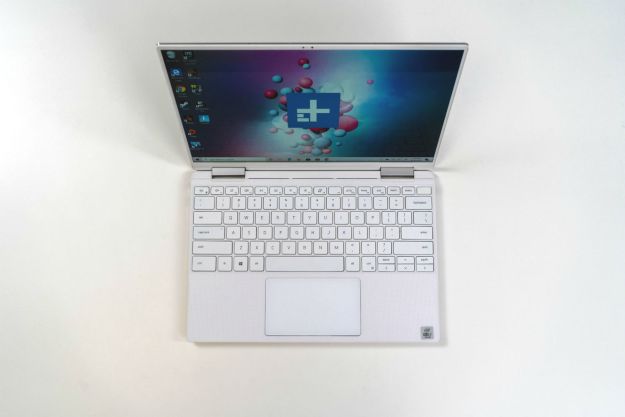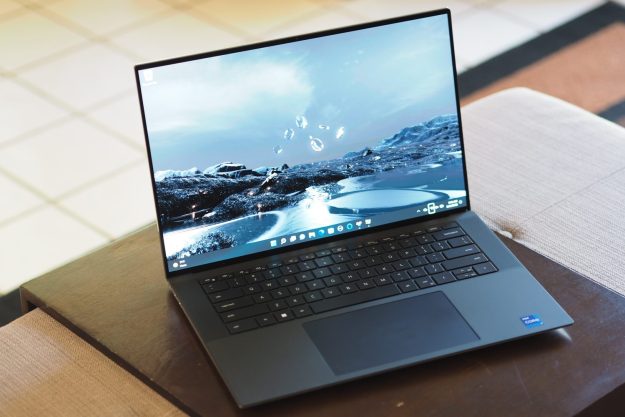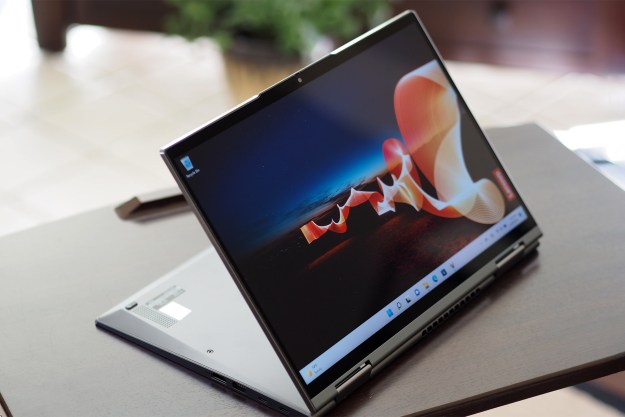
“Dell’s XPS 13 2-in-1 is first to dive into Ice Lake, and its design is a real revolution.”
- Refined design
- Even thinner bezels
- More screen space
- Iris Plus graphics are included
- Controversial keyboard
When the revamped XPS 13 launched earlier this year, I proclaimed it as a near-perfect laptop.
But behind closed doors, Dell was plotting how it could be better. The company was crafting the next evolution in XPS design — the XPS 13 2-in-1.
The $999 device looks similar to the older XPS 13 2-in-1 and current XPS 13 clamshell, but refinements and tweaks made to the the screen, keyboard, and performance place it on a new level.
More screen, less bezel

If you’re familiar with Dell’s XPS line, you know what it’s famous for. Super thin bezels, the use of a unique white weave along the palmrests, and great performance. But the design of the XPS 13 2-in-1 takes each of these things even further.
Let’s start with the bezels, which are as tiny as before. Now, the larger chin along the bottom is significantly reduced, to the point where the Dell logo has been removed. It’s a nice visual touch if you’d rather avoid in-your-face branding.
Dell has followed Apple’s lead on a number of key design choices.
In addition to thinning the bezels, Dell has implemented what’s called a reverse barrel hinge, which drops the screen just below the keyboard deck. It isn’t noticeable when you open up the laptop, but it means the screen sits a little lower, and it reduces the effect of that bottom bezel even more.
Instead of cutting the extra space out of the laptop entirely, the XPS 13 2-in-1 adds it to the screen. Its 13.4-inch diagonal size is stretched over a 16:10 aspect ratio, meaning it’s a little taller than the average laptop’s screen. It’s the same aspect ratio used by MacBooks. Dell has followed Apple’s lead on a number of key design choices throughout the device.

I find this size and aspect ratio close to perfect. After spending a lot of time using the Surface Laptop 2 as my daily driver with its boxy 3:2 screen, I always found it odd moving back to a 16:9 laptop. 16:10 is a happy medium most people will enjoy. The only downside is the letter-boxing that appears while watching video.
Speaking of video, the 2-in-1 functionality allows for a nice media view with the keyboard flipped around. This mode is good for use of the Dell stylus, though it isn’t included in the box. You’ll pay $99 (currently on sale for $69). If you do opt for it, the pen magnetizes to the right side of the chassis for safe keeping.
Beyond that, you won’t be using this as a tablet like you would an iPad. At 2.9 pounds, it’s 0.2 pounds heavier than the standard XPS 13. That’s light, but it’s too heavy to hold and use as a tablet for long.
That taller screen means this is a different panel than what a lot of 13-inch laptops use. Fortunately, it’s a step up in terms of quality. It’s insanely bright for an LED screen, maxing out at over 500 nits. It also has highly accurate colors, so I can safely recommend this as a laptop for photographers who need colors they can trust.
This is even on the FHD+ (1,920 x 1,200) model, which is the base option. I didn’t have chance to test the 4K model, but it likely exceeds the performance of the 1080p panel.
The webcam is still up top, as on the latest XPS 13. The one caveat is that it’s not an IR camera, so you’ll have to rely on the fingerprint scanner built into the power button to unlock your computer with Windows Hello. HP managed to squeeze a tiny bezel up top on its new Spectre x360, which does have an IR camera, so I’d like to see Dell do the same.
A beautiful keyboard that will scare some away
The XPS 13 2-in-1 has a chassis with more metal than ever before. Along the edges can you see the machined aluminum running almost all the up the side. It adds an extra bit of shine, as well providing added rigidity. I couldn’t feel much flexing or bending, and Dell’s tendency to use tight hinges means the screen doesn’t wobble as much when using the touchscreen.

The new keyboard is one of the more controversial changes. Everyone should enjoy the look of it, though. Dell’s font choice on the keycaps is lighter and more refined, and I love how the keyboard extends all the way up to the sides of the deck. It’s reminiscent of the defunct 12-inch MacBook. Visually, it feels like there’s less wasted space in the design. The same is true of the touchpad, which is wider.
The controversial part can be found underneath the keys. Dell is using butterfly-style mechanisms supported by magnets to create a short-travel feel. If that sounds familiar, you probably already know whether or not you’ll like the keyboard. It’s similar to typing on a modern-day MacBook.
I have to wonder if Dell might regret this design choice in a few years.
Much of this comes down to personal preference, but the shorter travel and unique typing sound doesn’t bother me. I found myself able to adjust within minutes.
However, I’m aware this will be a turn-off if you’re deserting the Mac world for this very reason. Reliability has been a long-term concern with this style of keyboard, though Dell has made copious claims about the longevity of its switches. Given the rumors that Apple will soon be moving away from butterfly switches, I have to wonder if Dell might regret this design choice in a few years.
Ice Lake brings the gift of Iris Plus
XPS laptops have long been among the fastest laptops in their class thanks to superior thermals. That’s no different here. The XPS 13 2-in-1 uses the latest 10th-gen Ice Lake processors. These are quad-core CPUs with plenty of power and efficiency, faster than previous generations in every benchmark I ran. It’s not much better with heavier loads like video encoding or editing, but the most significant improvement is in graphics.

Because this is Ice Lake, some models of the XPS 13 2-in-1 benefit from Iris Plus integrated graphics. Our review model, the Core i7-1065G7, featured the best Iris Plus can offer. This is still integrated graphics, so don’t expect to load up a modern triple-A game and run it at 60 frames per second. That’s not happening.
However, Iris Plus is around twice as fast as previous generations, allowing for a bit of light gaming.
I booted up Fortnite, and with some finagling, was able achieve playable framerates. I averaged around 35 FPS with the settings turned down to medium, and pushed it up to 60 once I dropped the resolution down a bit.
It’s not quite as good as some implementations of the Nvidia MX250 such as in the HP Envy 13. There are now portable 13-inch laptops, like the new Razer Blade Stealth, that come with a GTX 1650. Gaming is not the focus of the XPS 13 2-in-1, but you can have fun in a pinch.
It’s not perfect

As good as it sounds, the XPS 13 2-in-1 doesn’t defeat the standard XPS 13 in every way. Battery life is one. The XPS 13 2-in-1 often lasted me a full day of average work, though that’ll depend on your use. That beats a MacBook, though the XPS 13 will last a couple hours longer doing the same work. The same is true for an option like the HP Spectre x360, which has fantastic battery life.
Lastly, you’ll want to consider the port selection. There’s just two USB-C ports on either side of the device, along with a microSD card slot and a headphone jack. That’s the fewest ports I’d consider passable. It ties with the MacBook Air, and has one less USB-C port than the standard XPS 13.
Our take
The XPS 13 2-in-1 takes everything great about the original XPS 13 and bumps it up a notch. Whether it’s the taller screen or better graphics, the XPS 13 2-in-1 makes a case for itself in a way that the previous iterations never did. The XPS 13 still beats it in a couple of areas, such as ports or battery life, but Dell has made a serviceable competitor to what is already the best laptop.
Are there better alternatives?
The XPS 13 is the clearest alternative, providing a lot of the same look and feel as the 2-in-1. The clamshell has also been updated to 10th-gen but uses Comet Lake rather than Ice Lake. This gives the option for a six-core processor at the top end, while Ice Lake gives you the extra graphics boost thanks to Iris Plus.
Another strong competitor is the HP Spectre x360. The updated model has similarly thin bezels, the same Ice Lake processors, and fantastic battery life. I prefer the 16:10 screen and the design of the XPS 13 2-in-1, but they’re nearly a toss up in terms of features and performance.
How long will it last?
The XPS 13 2-in-1 should last you at least three or four years, thanks to its strong build quality and updated components.
Should you buy it?
Yes. The Dell XPS 13 2-in-1 is a great device that’s even sleeker than the already excellent XPS 13.
Editors' Recommendations
- Dell XPS 14 or XPS 16? Here’s how to know which to buy
- 9 best laptops of 2024: tested and reviewed
- The best 2-in-1 gaming laptops for 2024
- Dell just hit reset on the XPS
- The Dell XPS 15 has one major advantage over the MacBook Pro


